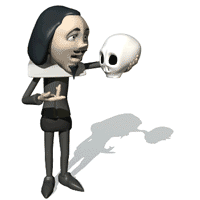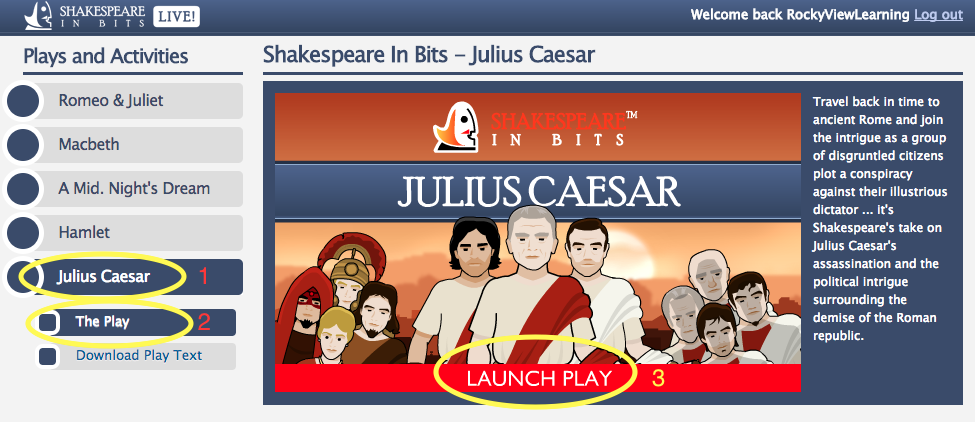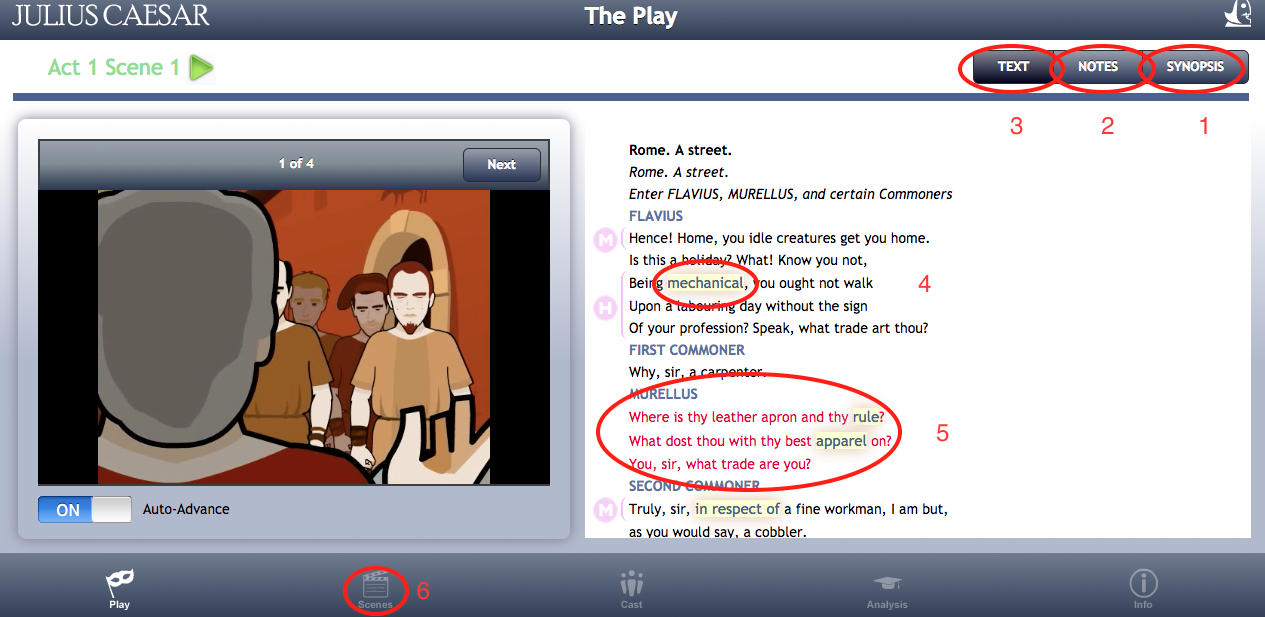Lesson Three - Hamlet
| Site: | MoodleHUB.ca 🍁 |
| Course: | ELA 30-1 RVSO |
| Book: | Lesson Three - Hamlet |
| Printed by: | Guest user |
| Date: | Monday, 10 November 2025, 9:00 AM |
Introduction
Lesson Four - Hamlet
Duration - 8 blocks (8 x 80 min + homework) "We all sympathize with Hamlet, and that is understandable, because almost every one of us recognizes in the prince, our own characteristics." - Ivan Turgenev (1818-1883) Russian novelist and playwright
"We all sympathize with Hamlet, and that is understandable, because almost every one of us recognizes in the prince, our own characteristics." - Ivan Turgenev (1818-1883) Russian novelist and playwright
Students often ask, "Why do we have to read Shakespeare?" It's a valid question, as, after all, his writing is over 400 years old. But, are the ideas he explored still valid today? Another valid question! What does Shakespeare have to say to a 21st-century audience?
- We have all procrastinated about something important that we had to do, sometimes disappointing other people and often disappointing ourselves. Why do we procrastinate?
- Most people have purposely "played the fool" at some time. Why do people do this? If a person, for some reason, plays the fool or pretends to be disturbed for a long time, do you think the person eventually can become truly disturbed?
- Isolation and loneliness are feelings common to most people at one time or another. Sometimes external circumstances create this situation, and sometimes people deliberately withdraw from those around them. What can friend or relatives do when someone has purposely withdrawn and chosen to be alone with his or her problems?
- Disillusion is a common experience of growing up. We find that people in the adult world whom we once idealized are less than ideal, and that situations we considered innocent are actually corrupt. How do young people encountering the "real world" for the first time handle these discoveries?
- In Shakespeare's time, insane people were regarded as sources of entertainment. What is our society's attitude toward mental illness?
- What is the difference between "taking revenge" and "getting justice"?
- Privacy is highly valued in our society. How would you feel if you found out that you were "under surveillance" at school, at your job, at home, or among friends because of some change in your behaviour?
Once you've thought about this wide range of topics, you're ready to explore Hamlet.
Hamlet Video and Text
- Copy the password so you can paste it when you open the website.
- Study the username.
- Click on the link and enter the Username and Password.
- Then click ENTER.
password: 1obySG3Ens3p
You will then see the kind of page listed below.
You will see all the plays available to you.
Click on "Hamlet", then "The Play", and then "Launch Play".

Once the play launches, you will then see this kind of screen:

The "movie" version of the play will instantly play. Use the usual "stop", "start", "pause" buttons as you watch.
For each scene, access it in this order:
- Click on "Synopsis" and read "What happens in this scene" so you know what happens!
- Click on "Notes" for further information you should be aware of.
- THEN click on "Text" to watch/read the scene.
- As the scene moves along, click on the words highlighted to get the modern version of them.
- As the various characters talk, their words are shown in red.
- Clicking on "Scenes" at the bottom of the screen gives you a quick way to access to whatever scene you want to watch/read.
Lesson
Hamlet is based on a Norse legend composed by Saxo Grammaticus in Latin around 1200 AD. The sixteen books that comprise Saxo Grammaticus' Gesta Danorum, or History of the Danes, tell of the rise and fall of the great rulers of Denmark, and the tale of Amleth, Saxo's Hamlet, is recounted in books three and four. In Saxo's version, King Rorik of the Danes places his trust in two brothers, Orvendil and Fengi. The brothers are appointed to rule over Jutland, and Orvendil weds the king's beautiful daughter, Geruth. They have a son, Amleth. But Fengi, lusting after Orvendil's new bride and longing to become the sole ruler of Jutland, kills his brother, marries Geruth, and declares himself king over the land. Amleth is desperately afraid, and feigns madness to keep from getting murdered. He plans revenge against his uncle and becomes the new and rightful king of Jutland. Saxo's story was first printed in Paris in 1514, and Francois de Belleforest translated it into French in 1570, as part of his collection of tragic legends, Histoires Tragiques. Saxo's text did not appear in English until 1608, so either Shakespeare was fluent in French or he used another English source based on the French translation. Generally, it is accepted that Shakespeare used the earlier play based on this Norse legend by Thomas Kyd, called the Ur-Hamlet. There is no surviving copy of the Ur-Hamlet and the only information known about the play is that it was performed on the London stage; that it was a tragedy; that there was a character in the play named Hamlet; and a ghost who cried "Hamlet, revenge!" - Sources for Hamlet
Read through the "Hamlet Introduction" document.
Consider the story outlines and questions that are raised.
Websites
Enjoying Hamlet
Hamlet Summary
Act by Act Summary and Analysis
Hamlet in modern English
Absolute Shakespeare
Ms Nakaska's Delicious Bookmarks - Hamlet
You are probably already familiar with some elements of Hamlet - the famous soliloquy that begins with the line, "To be, or not to be: that is the question," for example, or the image of Hamlet holding a skull saying, "Alas, poor Yorick! I knew him." As you begin to read the play, you will also recognize many of the plot elements, as they are often found in movies and television dramas today. For example, murder, betrayal, friendship, destroyed love, and revenge are all part of Hamlet. As well, when you become familiar with Hamlet's complex, multifaceted character, you may find yourself relating parts of his personality to your own.
- Use the "Shakespeare in Bits" version of Hamlet linked on the "Hamlet Video and Text" page to read / watch the play.
- You may also be interested in watching Kenneth Branagh's film version of Hamlet: HAMLET (starring Kenneth Branagh, 1996)
- Both of these resources contain the complete version of the play!!
Linked above are several websites containing analyses of Hamlet. You may want to explore them as you complete reading /viewing each act. Keep in mind that any website offering literary analysis are the opinions of one person - you may or may not agree with what you read.
Assignment
(100 marks)
Open a new Word document. Label it E301U2L3surname
In this document, complete the assignments outlined below.
Submit this assignment using the Dropbox for U2L3 Hamlet lies
Read the document, "The Ways We Lie".
Ms Ericsson presents a variety of ways that people lie:
- the white lie
- facade
- ignoring the plain facts
- deflecting
- omission
- stereotypes and cliches
- groupthink
- out-and-out lies
- dismissal
- delusion
Think about the various characters in Hamlet.
Consider how they may be untruthful to themselves and others.
- Write a brief introductory paragraph that will define what it means to lie and introduce the idea that lying is pervasive throughout Shakespeare's Hamlet.
- Choose FIVE different characters. Consider how each is untruthful.
- Choose one way that each character lies, according to how Ms Ericsson describes lying in her essay. You must choose a DIFFERENT type of lying for each character.
- Write ONE paragraph per character. Explain, in detail, which "method" your character uses to lie by referencing the essay. You must use three sets of evidence and explanation to support your conclusion. That is, you must present three specific details from the play and explain how each one supports your hypothesis. With an introduction and a concluding sentence, each of these paragraphs will be eight sentences.
- Write a final summary paragraph that explores what all of these characters who lie have in common.
Conclusion
"'Character . . . is destiny.' But not the whole of our destiny. Hamlet . . . was speculative and irresolute and we have a great tragedy in consequence. But if his father had lived to a good old age and his uncle had died an early death, we can conceive Hamlet having married Ophelia and got thorough life with a reputation of sanity, notwithstanding many soliloquies and some moody sarcasm towards the fair daughter of Polonius, to say noting of the frankest incivility to his father-in-law." - George Eliot (1819-1880) British novelist